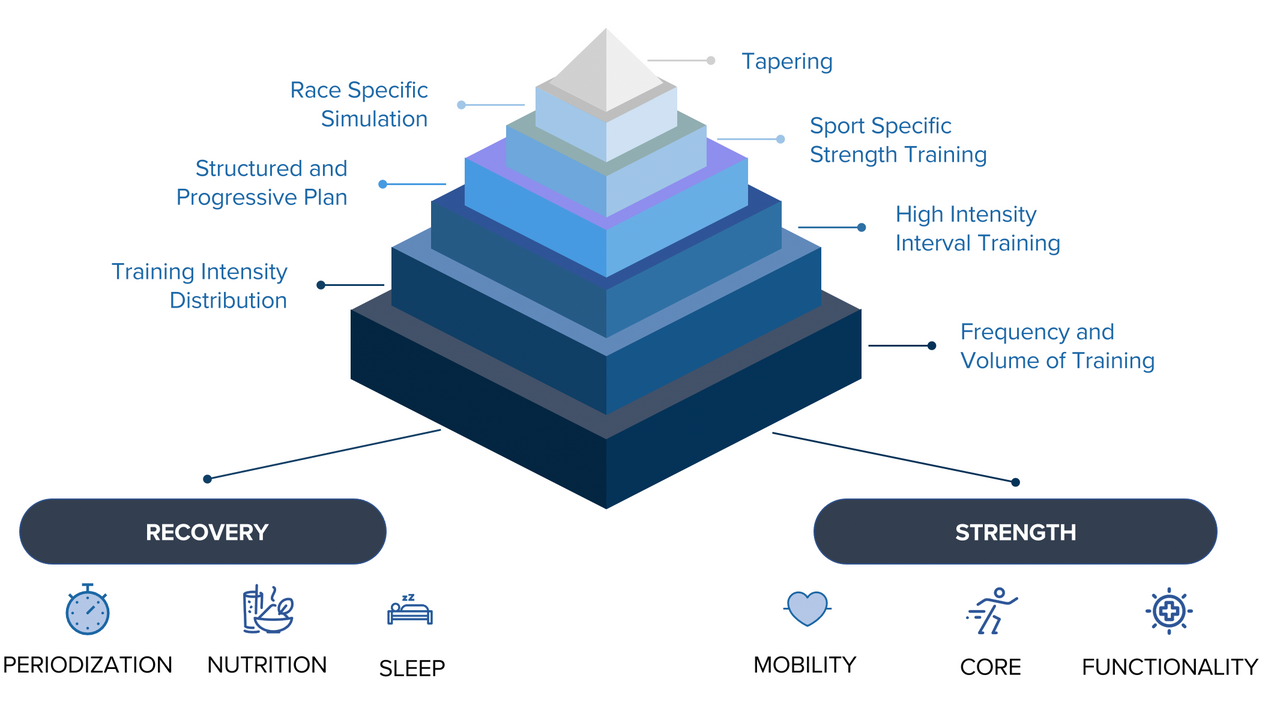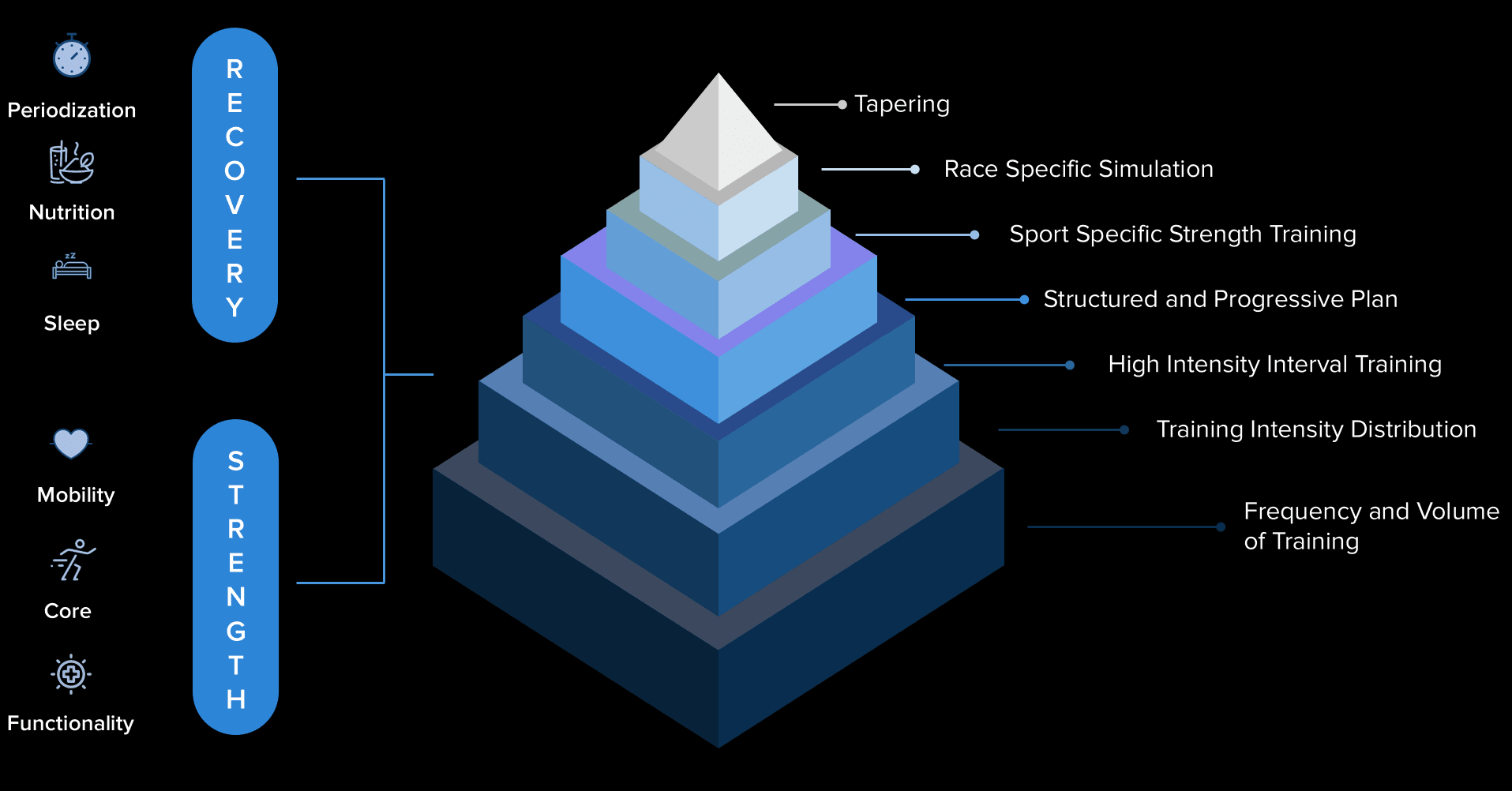Endure IQ's Hierarchy of Long-Distance Triathlon Needs

My long-distance triathlon training philosophy is grounded in the 'Hierarchy of Long-distance Triathlon Training Needs', a series of scientifically-supported components of a well-designed training programme. The Hierarchy is adapted from my colleague Prof. Stephen Seiler's 'Hierarchy of Endurance Training Needs', which was itself adapted from Maslow's famous 'Hierarchy of needs. This provides a firm basis for both our 1:1 and Endure IQ Training Squad athletes. It’s a method that works, tried and tested!
You can see my 'Hierarchy of Long-distance Triathlon Training Needs' below, which is from the Modules and content of our course on Training Programme Fundamentals, LDT102. This is for coaches and athletes who want to take their understanding of training programming to the next level. This blog will provide a brief background on the Hierarchy and introduce the pyramid's supporting features. Whilst these supporting structures aren't necessarily the fundamental training concepts, they are critical to support the training. Thereby improving the consistency and sustainability of the Long Distance Triathlete.

Figure 1: The Endure IQ Hierarchy of Long Distance Triathlon Training Needs and supporting structures.
Frequency and Volume of Training
At the base of the pyramid, you can see our foundational need – frequency and volume of training. Long-distance triathletes need to train often (frequency) and for a sufficient overall time (volume) to perform well in our sport. It is long-distance triathlon after all! The rationale behind the need for training frequency and volume is strong when you consider the training practices of professional athletes (4, 9, 12). The mechanisms behind improving with training involve activating signalling pathways that trigger small adaptations in response to each training session (8. This notion is supported in the literature as a whole (3).
Training Intensity Distribution
The next layer of the pyramid is something we talk about a lot, training intensity distribution (see my recent blog on this). Training intensity distribution refers to the percentage of overall training volume spent in different training intensity zones – below the first ‘aerobic’ threshold, between the two thresholds, and above the ‘anaerobic’ second threshold. Whilst different training intensity distributions can produce positive outcomes, I believe in emphasising training at low-intensity for long-distance triathletes, where ~80% of training time takes place below the first threshold. The rationale behind this is that training in this zone elicits low levels of stress, requiring minimal recovery (10, 11). Therefore, emphasising low-intensity training allows us to achieve high training frequency and volume. As for the remainder, I suggest long-distance triathletes start their plans with a polarised approach. Where the majority of higher-intensity training is focused on short intervals in the top zone, but, as we approach competition, pulling that back to longer intervals in the middle zone, which is a more race-specific intensity. We call this the polarised-to-pyramidal approach.
Sport Specific Strength Training
For sport-specific strength training, I refer to strength training done in a manner specific to long-distance triathlon. So, that likely includes running up steep hills or overgearing repetitions on the bike, pull and paddles on the water, where we are shifting towards producing higher forces to propel movement. Some studies have shown that this type of work is beneficial for uphill and flat-ground performance (6, 7). We should remember that our races don't take place on an indoor trainer or treadmill, so we will have to work on our ability to go uphill! See our blog on specific strength training here.
High-Intensity Interval Training (HIIT)
Next, we have HIIT, another topic that has seen significant chatter in our community. Even though we are training for a long-duration event at a low to moderate intensity, HIIT is a considerable driver adaptation. Such workouts are undoubtedly necessary to improve our long-distance performance (2). It is a challenge to manipulate interval training prescriptions and integrate them into our plan that emphasises high training frequency and volume! This is, of course, why systematic planning and structure is critical.
Structured and Progressive Planning
Structured and progressive planning refers to how we sequence and plan training, from the beginning of our programme to race day. In my opinion, this is distinctly different to the more traditional general annual periodisation most of us are familiar with. This is not something I really believe in, and the literature doesn't support its usage either (1). However, the real deal is progressive and structured training using monitoring tools (such as HRV) to a specific goal. I recommend loosely following a framework of general preparation phases, followed by specific phases, leading into race-specific stimulation (Competition Phase) and tapering. However, a good training program is about setting clear training goals that emulate competition and then building a concise roadmap to get there.
Race-Specific Stimulation
On race-specific stimulation, this is the next component of the pyramid. These are sessions that aim to replicate race-day intensities and sensations to ensure you're ready for the long-distance triathlon challenge. This ties in very nicely to the level of the pyramid below this one, a structured and progressive plan. Set the target with race-specific stimulations sessions, and then build a systematic plan to get there. Unlike shorter events such as a 5-km race on the track, or a time-trial on the bike, it is challenging, and perhaps not advisable, to practice a full Ironman in training. Therefore, we use specific training sessions to provide a race-specific stimulation.
Tapering
The peak of the pyramid is, funnily enough, when we do our peaking - tapering. Tapering occurs immediately in advance of the race, which aims to dissipate the fatigue generated in training whilst guarding against detraining. A well-executed taper generally involves a training volume reduction (~50%), with frequency and intensity maintenance (1, 5). See our blog on tapering here.
The Supporting Structures
As I alluded to earlier, none of these long-distance triathlon training needs can be achieved without careful attention to adequate recovery and a functional strength training routine. These form the supporting structure of the overall training plan. These two components allow for longevity in the life of the athlete and sustainable training.
Recovery
This is what I like to call the 3 pillars of recovery. We refer to the sequencing of our training across the training weeks to ensure adequate recovery between more demanding training sessions as the periodization of training. If we fail to properly periodize our training weeks, many athletes can find themselves completing their hard workouts back-to-back. Such inadequate recovery can result in fatigue, non-functional overreaching, and failure to properly absorb the benefits of a well-constructed workout. Sleep is crucial; without proper and sufficient sleep, we cannot effectively recover from training. As such our training quality and outputs deteriorate. This means we cannot properly absorb the load we put ourselves through. Poor sleep is also linked to injury and illness, so we want to avoid it as much as possible! Lastly, nutrition is the fuel we put in our engines to keep them running smoothly. Proper nutrition that includes all the micro-and macronutrients we need to fuel training, facilitate recovery, and promote appropriate adaptation for the long-distance triathlete should not be overlooked in the overall plan. I teach my low-carb nutritional approach for long-distance triathletes in LDT 101.
Strength Training
Last, we have strength training on the other side of our supporting structure (Figure 1). This differs from the specific strength training we have already talked about in swimming, cycling and running and refers to getting into the gym and completing the correct fundamental exercises. This means focusing on functional movements concentrating on myofascial slings, and good mobility within the required range of motion. The myofascial slings work in harmony to create strength and stability during movement. This reinforces the concept that we need to train movement patterns instead of individual muscles. A critical concept for strength training and this supporting structure. If you want to know more, read part 1 and part 2 of our blog on this.
Conclusion
So, that was a bit of a whirlwind tour, and by no means all the detail you need to build up a long-distance triathlon program. But the good news is, we can also do that for you! :) Still, hopefully, from this blog, you can see the many bases that I aim to cover – and you should – when preparing for your next Long Distance Triathlon. Of course, we cover all of these topics in a lot more detail in our courses and blogs.
Happy reading, and happy training!
EndureOn!
JOIN THE SQUAD
Take charge of your performance with proven training programs and workouts, adjustable to your needs, in the Endure IQ Training Squad.
LIMITED OFFER
